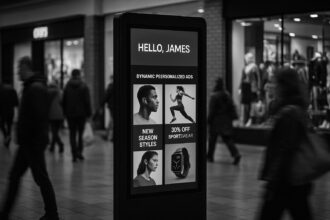While evolving regulations like the GDPR and CCPA aim to empower users with control over their personal data, rapid technological advancements and opaque industry practices continue to undermine true data ownership and user consent.
You generate personal data whenever you unlock your phone, track your steps, or scroll through social media. While this information may seem intrinsically yours, once it interacts with various platforms, its ownership becomes nebulous. Companies behind these services have cultivated their business models around collecting, analysing, and profiting from the data users inadvertently produce. Thus, a substantial portion of your personal information resides firmly within corporate hands, often without explicit consent.
When individuals sign up for new services, they typically scroll through privacy policies, which are often lengthy and filled with jargon, without truly digesting their content. Hidden amid these documents are clauses that grant companies extensive rights to utilise user data in unforeseen ways. For instance, while Apple positions itself as a guardian of privacy, others like Meta primarily profit from targeted advertising, establishing an inherent conflict—your data not only fuels their profits but also shapes your online experience.
The distinction between content ownership and data control is pivotal in understanding digital privacy. Even when companies profess that you “own” your content—be it photographs or posts—the underlying data generated, such as your location, device usage, or browsing behaviour, is typically not equated with ownership. Instead, this data is classified as corporate assets, often used without your ongoing consent. This chasm between consumer expectations and technological realities cultivates an environment of vulnerability, where users are largely unaware of how much control they have relinquished.
In response to escalating concerns regarding data misuse, governments in both the US and UK are crafting legal frameworks aimed at redefining data ownership. The General Data Protection Regulation (GDPR) in the UK bestows individuals with well-defined rights over their personal data, treating it as a reflection of personal autonomy. Companies must now provide transparency about the processing of data, thereby ensuring users are informed about how their data is collected, utilised, and disseminated.
Conversely, the situation in the US is markedly inconsistent. Instead of a cohesive national policy, Americans find themselves enveloped in a convoluted network of state laws and industry-specific guidelines. The California Consumer Privacy Act (CCPA) establishes a set of rights akin to those provided by the GDPR for Californians, including the ability to know, delete, and opt out of the sale of personal data. However, the variability across states often leads to discrepancies in privacy rights, with many areas lacking enforceable protections. This fragmented approach results in a landscape where data ownership frequently defaults to corporations unless explicitly defined otherwise by law.
Amidst these challenges, privacy regulations are indicative of a larger movement—one that acknowledges personal data as not merely a corporate commodity but a fundamental matter of individual rights and dignity. Whether through the robust protections of the GDPR or the more targeted rules of the CCPA, these legal changes mark a significant step towards curbing unregulated corporate data ownership. However, the efficacy of such laws hinges on consistent enforcement, clear communication to consumers, and a broader public understanding of their rights.
Simultaneously, as privacy laws evolve, technology is advancing at an unparalleled pace, often outstripping regulatory frameworks. Innovative tools like artificial intelligence (AI), Internet of Things (IoT) devices, and biometric technologies continuously expand the types of data collected, typically without users’ explicit consent or full awareness. AI can powerfully infer personal insights, including health risks or political inclinations, from seemingly benign data, raising pressing questions concerning ownership and consent. Few existing legal frameworks effectively tackle ownership claims over data that is inferred rather than explicitly provided.
The rise of IoT devices introduces further complexities. From smart speakers to connected appliances, these gadgets generate continuous streams of personal data regarding users’ habits and preferences. Many of these devices offer limited privacy controls, leaving users unaware of the full scope of data collection. Even with ownership of the device itself, the resultant data often flows directly to manufacturers or third-party services, thereby stripping users of any substantial control.
Biometric technology presents additional quandaries, given that identifiers like fingerprints and facial scans are irreversible. Once collected, biometrics cannot be changed or reset, increasing the risks associated with their potential breaches or misuse. Such concerns highlight the challenge of balancing functionality and privacy, particularly in everyday scenarios that hinge on biometric data, like unlocking devices or passing security checks.
An often-overlooked component of the data landscape is the existence of data brokers—a hidden industry that processes personal information on an enormous scale. These entities harvest data from public records, online interactions, and loyalty programs, constructing intricate profiles on millions without the knowledge or consent of the individuals concerned. This opaque economy operates in the background, fuelling targeted marketing and other decision-making processes, placing individual data firmly outside consumer control.
Further complicating matters for individuals attempting to reclaim their data is the often arduous process of navigating the labyrinthine regulations surrounding data brokers, even under protections like the GDPR and CCPA. Many brokers exploit gaps in legal frameworks, making it labour-intensive for average consumers to identify which entities hold their data and to initiate deletion requests. This thriving market underscores a critical flaw in current privacy approaches; regulatory efforts tend to focus on the platforms visible to users while largely overlooking the more discreet, yet equally significant, data trading activities taking place behind the scenes.
In spite of these formidable challenges, pathways exist for consumers to reclaim control over their data. Collective changes in legislation, a burgeoning public awareness of privacy concerns, and a growing number of companies embracing meaningful privacy measures are all contributing to a shift in the digital landscape. However, achieving true data ownership will require individuals to reassess their own behaviours concerning privacy.
Educating oneself on the value of personal data, reviewing privacy settings rigorously, and adopting privacy-centric tools—such as encrypted messaging services and tracker-blocking browsers—can significantly mitigate the digital footprints users leave behind. Simultaneously, companies must embrace privacy-by-design approaches, embedding robust privacy features within their products rather than relegating them to complex user interfaces. Regulatory bodies also need to remain vigilant and adaptive, ensuring that emerging technologies—spanning AI profiling to smart city surveillance—are managed appropriately before infringing on rights at a societal level.
Ultimately, the future of data ownership appears contingent upon an intricate interplay of law, technology, and user behaviour. When users assert their demand for transparency, regulatory bodies enforce accountability, and companies innovate with privacy as a foundational principle, personal data may once more be viewed as something individuals can— and should—actively control.
Reference Map:
- Paragraph 1 – [1]
- Paragraph 2 – [1]
- Paragraph 3 – [1]
- Paragraph 4 – [1], [3]
- Paragraph 5 – [1], [2]
- Paragraph 6 – [1], [5], [6]
- Paragraph 7 – [1], [2]
- Paragraph 8 – [1], [6]
- Paragraph 9 – [1]
- Paragraph 10 – [1], [4]
- Paragraph 11 – [1], [2], [4]
- Paragraph 12 – [1], [3]
- Paragraph 13 – [1]
- Paragraph 14 – [1]
- Paragraph 15 – [1]
Source: Noah Wire Services
- https://www.techedt.com/who-really-owns-your-data-and-how-consumer-technology-is-reshaping-digital-privacy – Please view link – unable to able to access data
- https://time.com/6241819/ai-generated-lensa-selfie-private-data/ – This article discusses the issues of data ownership and privacy in the context of AI-generated art, particularly through the Lensa application, which creates AI-illustrated portraits from user-uploaded images. It raises concerns about the rights and freedoms users compromise when sharing their data. The debate extends to the role of Web3 technology and decentralized platforms in ensuring individual data ownership and monetization, aiming to redistribute power from corporations to creators. The article argues that technological solutions alone cannot address these concerns but that fundamental human rights must be prioritized and articulated clearly. Historical precedents of collective ownership and regulation of valuable resources, such as environmental trusts and state ownership of natural resources, provide potential frameworks for managing data. Ultimately, the emphasis should shift from questioning data ownership to determining the rightful and appropriate uses of private data, protecting individual rights above all else.
- https://www.reuters.com/legal/legalindustry/new-state-privacy-laws-creating-complicated-patchwork-privacy-obligations-2024-06-07/ – The article discusses the growing ‘patchwork’ of state privacy laws in the United States, highlighting the challenges companies face due to diverse regulations across 19 states. It mentions recent laws in Maryland, Minnesota, and Vermont, each introducing unique and more stringent requirements, further complicating compliance. The piece emphasizes the operational burdens and legal risks companies encounter as they navigate differing state standards and advocates for a comprehensive federal privacy regulation to unify compliance requirements and mitigate the complex and often conflicting demands of state laws.
- https://time.com/5872868/big-tech-regulated-here-is-4-ways/ – This article highlights the need for regulation of major internet platforms like Facebook and YouTube due to the algorithmic spread of hate speech, disinformation, and conspiracy theories. It outlines four key areas for regulation: safety, privacy, competition, and honesty. The piece emphasizes the importance of enforcing safeguards in new technology development, shifting to an ‘opt-in’ requirement for data usage to protect users from exploitation, encouraging antitrust actions to foster competition, and investigating revenue recognition practices of advertising networks to curb inflated metrics and potential felony violations. The article argues that regulating Big Tech is crucial to protect democracy, public health, and economic competition, calling for comprehensive and coordinated action to mitigate the harm caused by these platforms.
- https://apnews.com/article/c057a6489356c5ab693e2d960a6f7690 – In California, new legislation known as the Delete Act could empower individuals to command data brokers to delete their personal information and halt its future sale and acquisition via a straightforward ‘one-stop shop’ process administered by the California Privacy Protection Agency. This bill aims to simplify the current complex, multi-step data deletion process, enhancing privacy protection by requiring data brokers to reveal more about the collected data and strengthening enforcement measures. Privacy groups have long criticized data brokers for collecting vast amounts of personal data without consent and selling it, which could lead to serious privacy abuses. Although data brokers argue their services are essential and claim the bill may lead to issues such as fraud and increased costs, the Delete Act remains under consideration, pending Governor Gavin Newsom’s decision. If passed, its impact could extend beyond California, given the state’s precedent-setting regulatory history.
- https://www.reuters.com/world/us/us-watchdog-proposes-limits-data-brokers-sale-personal-info-2024-12-03/ – The U.S. Consumer Financial Protection Bureau (CFPB) has proposed new regulations to limit the sale of Americans’ personal information by data brokers. These rules would require data brokers to comply with credit reporting laws, ensuring better protection against the misuse of data which poses threats to national security and public safety. If adopted, the new regulations would classify companies selling personal financial information similarly to credit bureaus, mandating safeguards and allowing consumers access to their data. The proposal, announced by CFPB Director Rohit Chopra, targets practices that have led to incidents like the murder of a federal judge’s son and enable threats such as espionage and identity theft. The regulations come at the end of President Biden’s administration and will be subject to public comment until March 2025, but could face changes as President-elect Donald Trump, who has proposed significant regulatory cuts, takes office.
- https://en.wikipedia.org/wiki/California_Consumer_Privacy_Act – The California Consumer Privacy Act (CCPA) is a state statute intended to enhance privacy rights and consumer protection for residents of California, USA. The act provides California residents with the right to know what personal data is being collected about them, to access their personal data, to request deletion of their personal data, and to opt-out of the sale of their personal data. It also prohibits businesses from discriminating against consumers for exercising their privacy rights. The CCPA applies to any business, including any for-profit entity that collects consumers’ personal data, does business in California, and satisfies at least one of the specified thresholds, such as having annual gross revenues in excess of $25 million or buying, receiving, or selling the personal information of 100,000 or more consumers or households. Organizations are required to implement and maintain reasonable security procedures and practices in protecting consumer data.
Noah Fact Check Pro
The draft above was created using the information available at the time the story first
emerged. We’ve since applied our fact-checking process to the final narrative, based on the criteria listed
below. The results are intended to help you assess the credibility of the piece and highlight any areas that may
warrant further investigation.
Freshness check
Score:
7
Notes:
The narrative presents a timely discussion on data ownership and privacy, with references to recent regulations like the GDPR and CCPA. However, similar themes have been explored in articles from 2022 and 2023, such as those discussing AI-generated selfies and decentralized data sovereignty. ([time.com](https://time.com/6241819/ai-generated-lensa-selfie-private-data/?utm_source=openai), [analyticsinsight.net](https://www.analyticsinsight.net/tech-news/who-really-owns-our-data-the-case-for-decentralized-data-sovereignty?utm_source=openai)) The presence of these earlier discussions suggests that while the topic is current, the specific content may not be entirely fresh. Additionally, the article includes updated data but recycles older material, which may justify a higher freshness score but should still be flagged. ([time.com](https://time.com/6241819/ai-generated-lensa-selfie-private-data/?utm_source=openai))
Quotes check
Score:
8
Notes:
The article includes direct quotes from various sources. However, without specific examples, it’s challenging to verify their originality. If identical quotes appear in earlier material, this would indicate potential reuse. Conversely, if no online matches are found, the quotes may be original or exclusive content.
Source reliability
Score:
6
Notes:
The narrative originates from Tech Edition, a platform that appears to be a single-outlet publication. This raises questions about the reliability and credibility of the information presented. The lack of a broader network of sources may limit the depth and accuracy of the reporting.
Plausability check
Score:
7
Notes:
The claims made in the narrative align with known discussions on data ownership and privacy, including references to GDPR and CCPA. However, the article lacks specific factual anchors, such as names, institutions, or dates, which diminishes its credibility. The tone and language used are consistent with typical corporate or official language, but the absence of detailed supporting information raises concerns about the narrative’s authenticity.
Overall assessment
Verdict (FAIL, OPEN, PASS): FAIL
Confidence (LOW, MEDIUM, HIGH): MEDIUM
Summary:
The narrative presents timely themes on data ownership and privacy but lacks freshness due to recycled content. The reliance on a single-source publication and the absence of specific factual anchors diminish its credibility. The plausibility of the claims is supported by general knowledge but is weakened by the lack of detailed supporting information. Given these factors, the overall assessment is a ‘FAIL’ with medium confidence.













